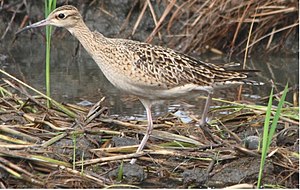Whimbrel
| Whimbrel | ||||||||
|---|---|---|---|---|---|---|---|---|

Whimbrel ( Numenius minutus ) |
||||||||
| Systematics | ||||||||
|
||||||||
| Scientific name | ||||||||
| Numenius minutus | ||||||||
| Gould , 1841 |
The whimbrel ( Numenius minutus ) is a wading bird from the species-rich family of snipe birds . It is a very small curlew and closely related to the probably extinct Eskimo curlew ( Numenius borealis ).
description
The whimbrel reaches a length of 28 to 34 centimeters, a wingspan of 57 to 63 centimeters and a weight between 150 and 175 grams. This makes it no larger than the golden plover ( Pluvialis apricaria ). However, his appearance shows him as an unmistakable representative of the curlews.
It is predominantly gray-brown in color, including the lower wings. Its belly is white and it has a short, curved bill. The whimbrel has a head pattern similar to that of the whimbrel ( Numenius phaeopus ), with light and dark stripes on the top of the head and an eye stripe. His call consists of constantly repeated whistles.
Habitat and way of life
The curlew is a migratory bird . Its winter quarters are in Australasia . However, he has also been observed as a rare guest in western Europe.
This bird breeds in loose colonies, preferably on old forest fire areas and river valleys in north-east Siberia . Its nest is a hollow in the floor in which up to four eggs are laid. It winters in the south on grasslands, in arable areas or near bodies of water, especially in northern Australia but also south of St Kilda in South Australia .
The whimbrel is sociable and forms large schools. It feeds on invertebrates, which it tracks down in the soft mud.
literature
- Peter Hayman, John Marchant & Tony Prater: Shorebirds - an identification guide to the waders of the world. Helm, London 1986, ISBN 0-7099-2034-2 .
Web links
- Numenius minutus inthe IUCN Red List of Threatened Species 2015.4. Listed by: BirdLife International, 2012. Retrieved April 11, 2016.
- Videos, photos and sound recordings for Numenius minutus in the Internet Bird Collection
- Waterbirds around the World - Status and conservation of the Little Curlew Numenius minutus on its over-wintering grounds in Australia PDF file (772 kB)
- Birds in Backyards - Little Curlew (English)